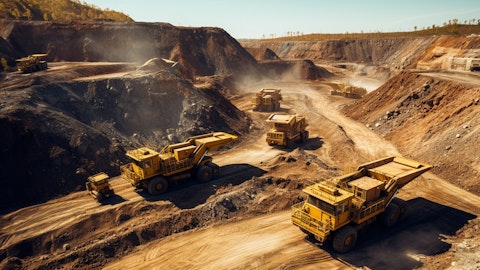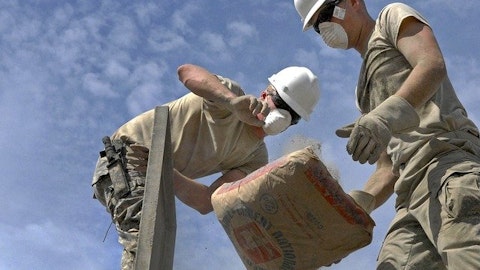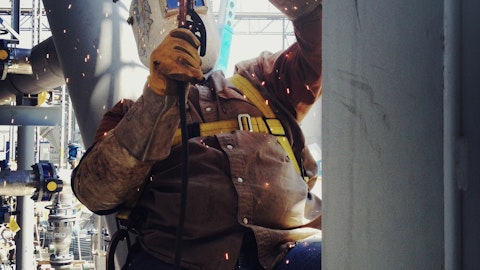Stanley Elliott: Hi. Good morning, everybody. Thank you for the question. Hi, Tom, could you talk a little bit more about kind of what you’re seeing at the state budget level? It seems to be kind of a different part of the story maybe from prior years. And just how that can help the public markets accelerate into next year?
Tom Hill: Yes. Good question. And actually, it’s going well. As you know, we always say it takes two years for the money to go to work. And if you remember, IIJA was past November of ’21. So we are at a two-year mark, and we are starting to see it come on. It’ll be a gradual growth rate over time. We will see growth in 2024. We see it in the awards. Trailing 12 months is up 17% on awards. But if you look at the – to your point, if you look at the state DOT capital budgets for 2024, they’re actually really big. You probably won’t see all of that in ’24, but it’ll sure sets us up well. For example, I think Alabama is up 29% capital budget. California is up 5%, but 50% over three years in California. So we are starting to see that money flow through.
Florida will be up 20%. Tennessee’s budget doubles. And Texas is up 21%. So this will be a multi-year play. They can’t put all that money to work in 2024, but sure sets us up. Some of it will go to work in ’24, but it sets us up also for ’24 and ’25. I think that, again, all this is really setting us up well for ’24, ’25 and ’26.
Stanley Elliott: Perfect. Thanks so much.
Tom Hill: Thank you.
Operator: The next question comes from Kathryn Thompson with Thompson Research Group. Please go ahead.
Tom Hill: Good morning, Kathryn.
Kathryn Thompson: Good morning. Thanks for taking my question today. I know there’s a lot of questions just about the rest of ’23 and the outlook for 2024. But stepping back and looking at the big picture, there’s been a bit of activity in the industry from an M&A standpoint and some rumblings of greater slowdown in the economy in 2024, which can be opportunities for growth for companies well as positioned as yourself. As you think about these type of opportunities and just areas of growth for Vulcan, how do you position yourself and what geographies and/or products are at top of the list in terms of growth initiatives for Vulcan? Thank you.
Tom Hill: Yes. Well, aggregates is always going to be the top of the list, and bolt-ons in our footprint will give us the best returns. As I look at the M&A market right now, from, say, six or eight months ago, it’s actually picked up. I think over the next several months, over the next several quarters, we should see some strategic bolt-on acquisitions. And I think that we’ve got some really good opportunities there. I think we’ll also, over the next two years, see a marked pickup in greenfield starts as we got some really good opportunities in adjacent markets to add some new facilities that we’ve been working on for the last five to 10 years. So I think both will pick up. As always, our biggest growth engine is going to be improving cash gross profit per ton in aggregates.
And I think, as we’ve heard earlier in this conversation, while we’ve had a great year in ’23, I think we’ll also have a really strong year because of pricing momentum and our operating disciplines as we look out to 2024. So I’m very encouraged with growth on all fronts at this point.
Kathryn Thompson: Okay. Great. Thank you.
Tom Hill: Thank you.
Operator: The next question comes from Jerry Revich with Goldman Sachs. Please go ahead.
Tom Hill: Morning, Jerry.
Mary Andrews Carlisle: Morning.
Jerry Revich: Hi, Tom, Mary Andrews. Good morning. I’m wondering if we could just talk about the opportunity that you folks have from the logistics services and other initiatives outside of price cost. You’ve had, over the past 10 years, 10% compounded CAGR and profitability. You’ve had some contribution outside of price cost from those initiatives. And can we just ask you for an update on how that’s tracking and the opportunity set over the next couple of years?
Tom Hill: Yes. That’s – it’s quietly gone very well for us, and that’s been, I think, a strategic advantage of servicing our customers, particularly on these very large projects. They’re complex. They are all – quality and delivery makes a big difference, because those projects have a time frame and some of them have damages, if you’re not on time and if you can’t get it there and get the right product there to hold the project up, it’s worth more than the price of aggregates. So I think that, both from a price perspective and a volume perspective, quietly has been a strategic advantage for us.
Jerry Revich: And the outlook from here, Tom? Any particular acceleration, because it seems like it’s contributed to the unit profitability CAGR about 1 points to 2 points generally?
Tom Hill: Yes. I think that it will continue to grow. I think we continue to add new features to that, including back office features that make it easier for our customers to do business with us. So I think, again, we’re not done with it and we continue to learn and improve upon it.
Jerry Revich: Thanks.
Tom Hill: Thank you.
Operator: The next question comes from Mike Dahl with RBC Capital Markets. Please go ahead.
Tom Hill: Morning, Mike.
Mary Andrews Carlisle: Morning.
Mike Dahl: Morning. Thanks for taking my question. We talked about the downstream businesses, maybe give us an update on how you’re thinking about them for this year within the guide and then if you do have any initial thoughts on kind of the volume and price or price cost outlook, similar to how you outlined for aggregates for your downstream businesses next year, that would be great.
Tom Hill: Yes. So asphalt, it’s been a great year. It was a really strong quarter. Volumes were up 11%, margins up 50%. And we really helped – first of all, we are in really good asphalt markets, but we’re also obviously helped by liquid – fall in liquid and, on top of that, really good pricing momentum for hot mix. As we look to 2024, I’d say we are still doing the work. I think there’s potentially some challenges from liquid pricing going up. I think demand will be okay, but I think we’ll give you a lot more color in February. As I looked at ready-mix, as we called out kind of early in the year, where we struggled with unit margins because of inflation and energy last year, we got past that with price as we predicted. Volumes in the quarter were a little challenged on a same-store basis, and that’s really driven by single-family construction.
But prices were up 10% and unit margins were up over 30%. Next year, I think it’s a little early to call, because of the volatility in the private side. We just got to see more. That said, I think we do have pretty good pricing momentum going into ’24 on concrete.




